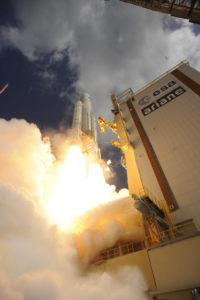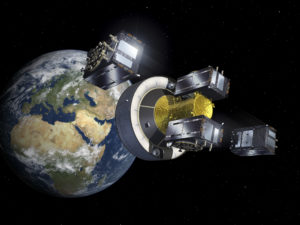
The Ariane 5, operated by Arianespace, lifted off from Europe’s Spaceport in Kourou, French Guiana at 13:06 GMT (14:06 CET, 10:06 local time) carrying Galileo satellites 15–18. The first pair was released 3 hours 35 minutes and 44 seconds after liftoff, while the second separated 20 minutes later.
The Galileos are at their target altitude, after a flawless release from the new dispenser designed to handle four satellites.
See here the liftoff replay.
Over the next few days, engineers will nudge the satellites into their final working orbits and begin tests to ensure they are ready to join the constellation. This is expected to take six months or so.

Galileo satellites 15–18 being deployed from their dispenser at 22 900 km altitude starting 3 hr 35 min after launch. They deploy two at a time, with the second pair deploying 20 minutes after the first. They then manoeuvre themselves up another 300 km to their final working orbit, leaving their Ariane 5 EPS upper stage in a safe ‘graveyard orbit’.
This mission brings the Galileo system to 18 satellites.
The satellites already in orbit will allow the European Commission to declare the start of initial services, expected towards year’s end.
The previous 14 satellites were launched two at a time using the Soyuz–Fregat rocket.
“Now that we can rely on the powerful Ariane 5, we can anticipate the quicker completion of Galileo deployment, permitting the system to enter full operation,” remarked Paul Verhoef, ESA’s Director for the Galileo Programme and Navigation-related Activities.
Two additional Ariane 5 launches are scheduled in 2017 and 2018. The full system of 24 satellites plus spares is expected to be in place by 2020.
“With this 75th successful launch in a row, Ariane-5 sets a new record within European developed launchers and proves once more its reliability, ” said Daniel Neuenschwander, ESA’s Director for Launchers.
